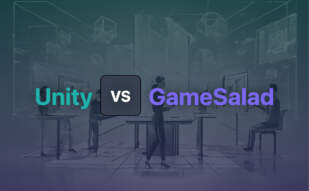GameSalad offers a free, drag-and-drop game creation engine used to develop iOS, Android, and HTML5 games. It supports multi-platform publishing, provides an In-App Previewer for testing, and enables web publishing. Main features include a drag-and-drop coding platform, social features, and monetization options. It supports educational initiatives and has been used in over 223 schools.

For those exploring options beyond GameSalad, alternatives include: Construct 3, Unity, Godot, Unreal Engine, GameMaker, Android Studio, Solar2D, RPG Maker, Panda3D, Stride, jMonkeyEngine, O3DE, LibGDX, Pygame, SpriteKit, Babylon.js.
Construct 3

Brought to you by Scirra Ltd, Construct 3 is a HTML5-based 2D video game engine catered towards both complete novices and seasoned developers. Notable for its web-based application, this engine runs on logic-based actions, significantly reducing the time needed in game development.
Construct 3 Top Features
- Simplified visual programming through ‘event sheets’
- In-built pixel editor for game graphics
- Supports variety behaviors including solid, platformer, tile movement, and anchor
- Availability for offline use
- Compliance with data privacy regulations such as COPPA, CCPA, and GDPR
| Supports Browsers | Google Chrome, Firefox, Internet Explorer 9+, Safari 6+, and Opera 15+ |
| Language Integration | Optional JavaScript scripting |
| Target Users | Indie developers, Educators, Schools |
Construct 3 Limitations
- Challenges in creating large-sized games
- Not a viable solution for 3D game development
- Limited support for platforms like Apple TV due to lack of native and offline application behavior
Construct 3 Pricing
Construct 3 offers a free license version with limited features and a paid subscription starting at $99/year for personal use, offering more advanced features.
Construct 3 Use Cases
Use Case 1: Educators and Schools
Construct 3 is a popular choice among educational institutions. Its simple programming method presents an engaging way for students to master coding and game design.
Use Case 2: Indie Developers
For indie developers, the ease of use and swift game creation offered by Construct 3 make it an appealing choice for creating 2D games or playable advertisements.
Use Case 3: Professional Developers
With the availability of JavaScript integration, Construct 3 satisfies advanced developers’ needs with its programming flexibility and versatility.
Unity

Having launched in 2005, Unity is a powerful and robust platform for developing both 3D and 2D games. Widely recognized for its adaptability across multiple operating systems, it has enabled developers worldwide to create a spectrum of applications ranging from Augmented Reality to 3D simulations.
Unity’s Praiseworthy Features
- Provides cross-platform game deployment including Android and iOS platforms.
- Facilitates the production of sophisticated games via both the free and paid versions of Unity with comprehensive features.
- Unity’s rich asset store integrated with diverse pre-designed textures and features stimulates the game design process for developers.
- Supports a variety of coding languages including BOO script, Javascript, and C#.
- Engages a large, active developer community for assistance, feedback, and system improvement initiatives.
| Top Feature | Benefit |
|---|---|
| Cross-platform compatibility | Helps developers target a large audience irrespective of platform preferences. |
| Diversity in coding languages | Fosters flexibility and comfort in coding, catering to developers’ specific language expertise. |
| Rich Asset Store | Makes brainstorming for game designs more efficient and inspiring, contributing to higher quality products. |
Unity Limitations
- Under the new pricing model effective from January 1, 2024, developers pay a fee each time a game using Unity software is installed. This has spurred concerns about potential abuse of per-install fees and has damaged the trust between Unity and its users dramatically.
- Some developers argue that sudden changes in Unity’s pricing could compromise their financial sustainability.
- The removal of the Unity Plus subscription tier has brought dissatisfaction among a section of users.
Unity Pricing
A pivotal element in Unity’s offering is its pricing model. As of January 1, 2024, developers must pay a fee each time a Unity-based game is installed. However, the company states that developers will not be charged an install fee until their game surpasses $200,000 in revenue and 200,000 installations. This structure varies depending on the market—games installed in standard markets like the US and UK bear a higher fee compared to emerging markets such as India and China.
Unity Use Cases
Mobilizing Game Development
Thanks to its cross-platform compatibility, Unity provides a fertile ground for creating exciting mobile games whether they’re for iOS or Android.
Augmenting Reality
Unity’s powerful feature set and adaptability enable it to be an excellent tool for developing AR/VR games, bringing immersive experiences to gamers all over the world.
Indie Game Development
Despite the pricing controversy, Unity’s all-around capabilities make it a sought-after platform for indie game developers, providing them with robust tools to bring their creative visions to life.
jMonkeyEngine
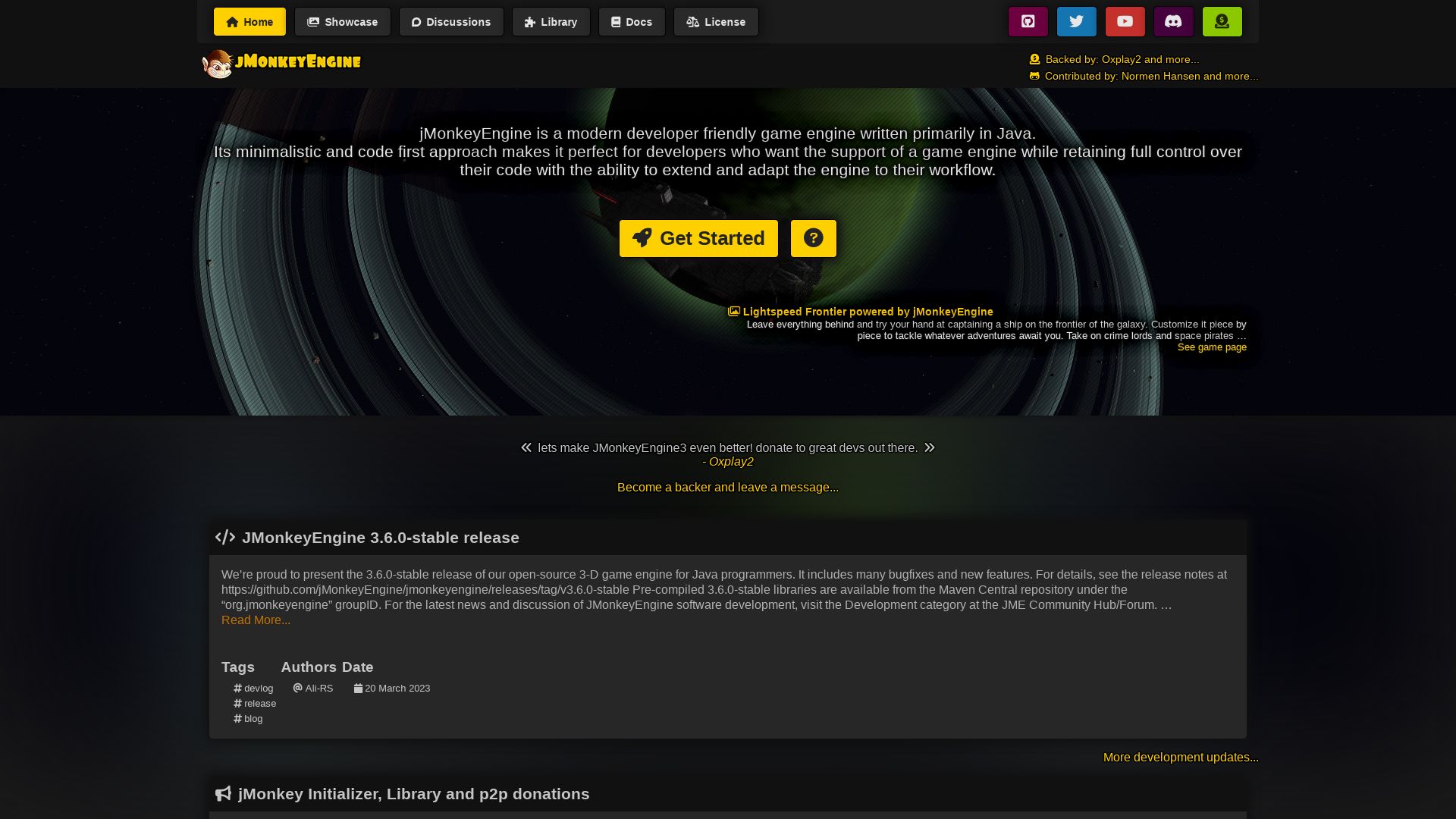
Revolutionize your game development process with jMonkeyEngine, a robust, Java-based game engine that harnesses the power of the NetBeans Platform. With impressive Android capabilities and a design-focus catering to developers, jMonkeyEngine stands apart with a minimalist, code-first approach.
jMonkeyEngine Top Features
- 3D Capabilities: Backed by open-source roots, the 3.6.0-stable release empowers Java programmers to create immersive 3D games.
- Project Creation: Generate new projects seamlessly with the jMonkeyEngine Initializer, a novel web-based tool.
- Audio Support: Enrich user experience with 3D audio support, powered by OpenAL, and jmePhonon for immersive sounds.
- Rich GUI Options: Drive user interaction with diverse GUI options including Lemur, Nifty GUI, and IGUI.
| Networking Options | Spidermonkey, SimEthereal, Monkey Netty |
| Post-Processing Support | Bloom FXAA, Light Scattering, etc. |
| Compatible Platforms | PC, Linux, iOS, Android, and Mac |
jMonkeyEngine Downsides
- Might seem intense for beginners as it’s more of a lower-level game development tool.
- Though it surpasses Unity in some aspects, it still has certain limitations.
jMonkeyEngine Pricing
With a commitment to accessibility, jMonkeyEngine is entirely free, open-source and operates under a permissive BSD 3-Clause license.
jMonkeyEngine Use Cases
Use case 1: Game Education Programs
jMonkeyEngine lights the spark of creativity in game-education programs. Its user-friendly interface and wide range of capabilities make it a powerful tool for both young and adult learners.
Use case 2: Commercial Game Development
With multiple commercial games to its credit, jMonkeyEngine is a preferred choice in serious game development projects, thanks to its higher adaptability and easier learning curve.
Use case 3: Platform Publishing
Whether your target audience is on PC, Linux, iOS, Android, or Mac, jMonkeyEngine’s cross-platform compatibility ensures your game reaches everyone, everywhere.
O3DE
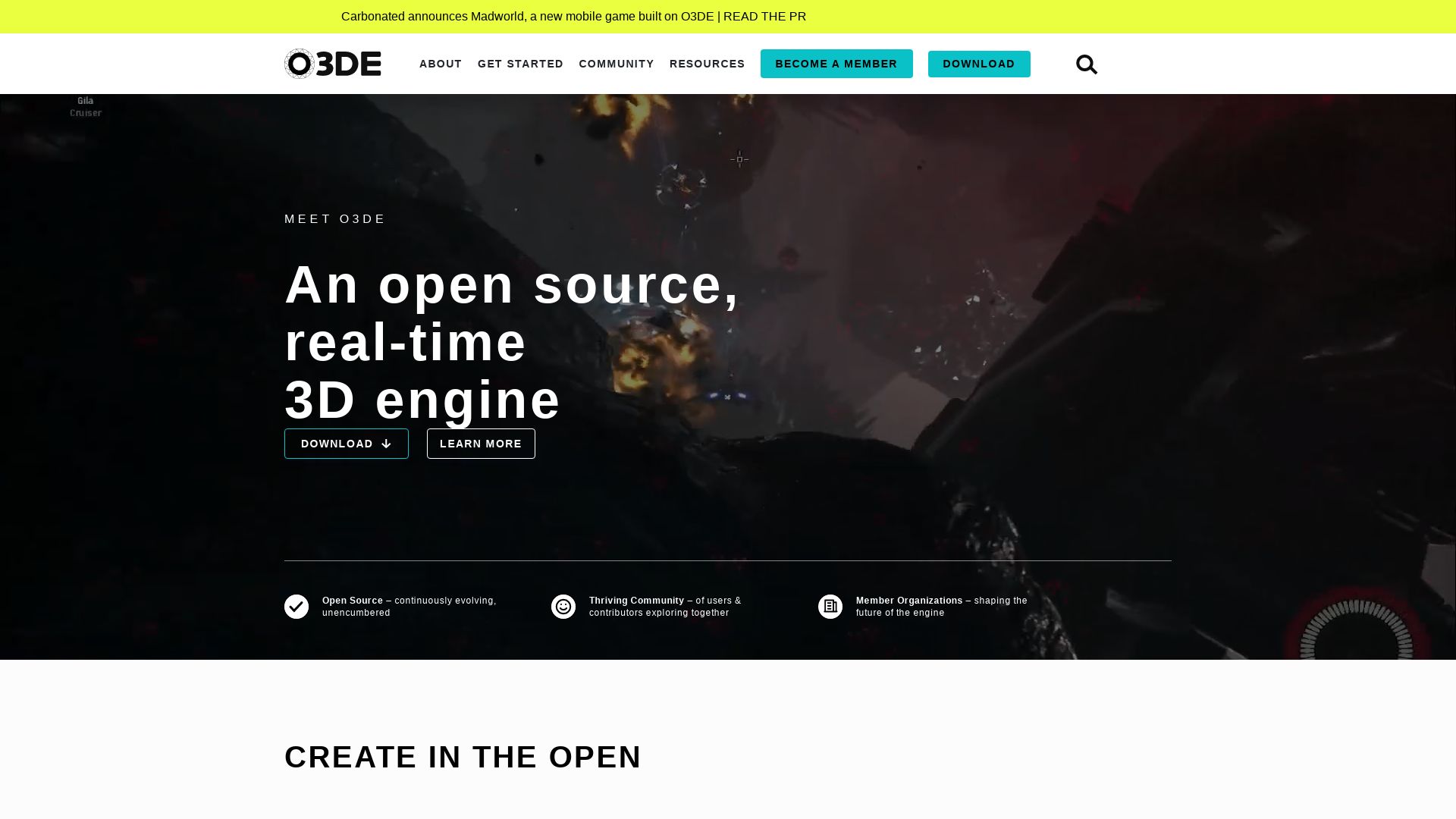
Spearheaded by the Open 3D Foundation, O3DE or Open 3D Engine flares as a potent, open-source, formidable force among the animated 3D engines used for constructing intricate games/simulations.
O3DE Top|Best Features
- Modular engine: Organized into Gems, allowing users to add/remove components without recompiling O3DE.
- High performance: Built for interactive experiences with advanced physics simulation and animations.
- Advanced build automations: Utilizes CMake to automate code and generate build files.
| Feature | Description |
|---|---|
| Script Canvas or Lua for runtime logic | O3DE offers Script Canvas, a visual scripting environment, as well Lua for versatile game logic scripting. |
| Python scripting support | Aside from Lua, O3DE also provides Python scripting for extended functionalities. |
| Data-driven asset workflows | With this feature, developers can streamline the creative process by handling assets in an organized, efficient manner. |
O3DE Limitations
- Lack of widespread adoption due to its recent release in 2021.
- Requires a high minimum system requirement of Windows 10 1809 or Ubuntu 20.04.
O3DE Pricing
This potent engine capitalizes on its open-source nature, rendering it entirely free for use, fostering an inviting ecosystem for developers.
O3DE Use Cases
Use case 1
Given its physics simulation and high-performance capabilities, O3DE shines when deployed for complex game development.
Use case 2
Through its specialized Gems, O3DE offers developers flexible customizations, making it suitable for interactive experience creations.
Use case 3
By leveraging its Python scripting support, O3DE provides a powerful framework for developing advanced functionalities in applications.
LibGDX
Allow me to introduce you to LibGDX, a well-established Java game development framework. With over ten years of existence and an extensive third-party ecosystem to its credit, it is committed to providing a unified API for cross-platform targeting, encompassing Windows, Linux, macOS, Android, iOS, and the Web, with flawless rendering via OpenGL ES 2.0/3.0.
LibGDX Top Features
- Finely-grained, code-centric control with IDEs, Git support, debuggers, profilers, libraries, and frameworks.
- Wide selection of inputs and gestures support.
- Fuses two-dimensional physics via Box2D and three-dimensional physics via Bullet physics.
- Obliging integration of game services: Google Play Games, Apple Game Center.
- AdMob integration for monetization.
- Meshes, textures, framebuffer objects for advanced graphics features.
- 3D APIs include GLTF 2.0 support and VR support.
| Networking | Supports TCP sockets, HTTP requests, WebSocket support. |
| Open-source | Fully open-source under Apache 2.0 licensing. |
| Community Support | Large community support, online forums, Discord community, and Wiki tutorials. |
LibGDX Limitations
- Requires a solid understanding of the Java programming language.
- Lack of an intuitive interface for beginners.
LibGDX Pricing
Rest assured, LibGDX remains an open-source asset, free to use.
LibGDX Use Cases
Use case 1
Independent Game Developers: LibGDX is a boon to indie developers aiming to deploy their creations on multiple platforms. Its comprehensive feature set and extensive documentation assist in quick and efficient game development.
Use case 2
Education: Its pure Java nature and transferability across platforms, makes LibGDX a suitable learning tool for aspiring game developers, unlocking a practical perspective into the world of game development.
Use case 3
3D Game Development: Equipped with advanced 3D features including lighting systems, GLTF 2.0 support, and VR support, LibGDX is well-equipped for creating as well as testing 3D games.
Pygame

A community-driven, highly portable game development platform, Pygame is a set of Python modules designed specifically for creating video games. First released in October 2000, it has evolved to be one of the easiest and most accessible platforms in game development, particularly for beginners and first-time programmers.
Pygame Top Features
- Originally authored by renowned developers such as Lenard Lindstrom, René Dudfield, Pete Shinners, and more.
- Offers cross-platform capabilities and runs on almost every operating system.
- Decreased coding time due to Pygame’s code being 10-20 times faster than standard Python code.
- Availability of code written in Python, C, Cython, Assembly language.
- The Simple DirectMedia Layer (SDL) library enables simplified real-time game development.
- Can adjust background scrolling speed and has control over the game’s speed.
| Feature | Details |
| Android Compatibility | Pygame is compatible with Android devices through Pygame Subset for Android (pgs4a), providing support for sound, vibration, keyboard, and accelerometer. |
| Learning Resource | Community-created tutorials facilitate new user learning. Used widely for kids, college students, and first-time programmers. |
| Game Offering | Allows creation of open-source, freeware, shareware, and commercial games. |
Pygame Disadvantages
- Limited to less than 60k token length.
- While Pygame code is fast, Assembly Language execution is still 100 times faster than Python.
- Requires broad programming knowledge, as it operates in multiple languages including Python, C, Cython, and Assembly.
Pygame Pricing
As Pygame operates under the GNU Lesser General Public License, it’s free and open-source.
Pygame Use Cases
Use case 1: Lessons for Young Kids
Pygame is an exceptional tool for teaching kids about programming and game development due to its easy-to-understand language and comprehensive community tutorials.
Use case 2: College Students
For college students studying coding or game development, Pygame offers a highly accessible, hands-on learning platform with quick coding times.
Use case 3: First-time Programmers
Pygame empowers first-time programmers to navigate the world of game development with ease, thanks to its supportive community and user-friendly modules.
SpriteKit: Unleash Your Game Development Prowess
![]()
Enter the world of SpriteKit, Apple’s potent game development framework for iOS and macOS. Designed specifically for 2D games, it blends user-friendly capabilities with animated graphics and physics-based gameplay for an engaging gaming experience.
SpriteKit’s Exceptional Features
- Built on the SceneKit framework, stepping up game development to a new level.
- Eases the creation and animation of 2D game objects, bringing your ideas to life.
- The powerful Box2D physics engine for realistic object interactions.
- Supports Swift language enhancing your code efficiency.
- Packed with comprehensive support for Game Center and iCloud, allowing cross-platform game creation.
- Comprises four main components, the Scene, Node, Sprite, and Action, laying a solid foundation for game-building.
| Major Components | Description |
|---|---|
| Scene | The backdrop of the game which hosts sprites and defines the environment. |
| Node | An element capable of rendering graphics, handling touch events and running actions. |
| Sprite | A 2D graphic object that can be moved on screen and interacts with others visually. |
| Action | A simple, reusable chunk of code that can perform a variety of functions in your game. |
Challenging Aspects of SpriteKit
- SpriteKit’s full potential is unlocked only with expertise in Swift and iOS development.
- About collision accuracy: Opting for a circular shape can heighten performance, albeit at the cost of accuracy. Conversely, an alpha mask amplifies accuracy, but at the expense of performance.
- Game development with SpriteKit is restricted to Apple’s ecosystem.
The Price of SpriteKit
SpriteKit comes bundled with Apple’s development environment and is available at no additional cost. Please refer to Apple’s official website for more information.
Possible Applications of SpriteKit
Use Case 1: MVP Methodology
SpriteKit is excellent for game developers focused on implementing the Minimum Viable Product methodology. Its advanced features expedite the process of building and launching your first game, maximizing efficiency within the development cycle.
Use Case 2: Game Analytics
With SpriteKit’s compatibility with Game Center and iCloud, it invites opportunities for robust game analytics, providing insights about player behavior and preferences, directly aiding in future game enhancements.
Use Case 3: Cross-platform Gaming Experience
Thanks to its cross-platform game creation capability via Game Center and iCloud support, SpriteKit is an ideal choice for developers wanting to deliver a seamless gaming experience across iOS and macOS platforms.
Babylon.js
In the expanse of 3D engines, Babylon.js, authored by David Catuhe, takes prominence. Engineered by global tech influencer, Microsoft, and other esteemed contributors, Babylon.js ushered a new epoch in 3D graphic display when it entered the tech domain in 2013. Its pedigree of open-source code hosted on GitHub and the guidance of Apache License 2.0 lend it distinguished authenticity.
Babylon.js Top Features
- Tracks its origins to the fast-paced real-time gaming environment, adding hefty credentials to its repute.
- Built on TypeScript and JavaScript, being both nimble and versatile.
- Preserves 3D graphics’ integrity through HTML5 on web browsers, extending a smooth user experience.
- Wields power from a robust API, opening up vast possibilities for user projects.
| FEATURE | DETAIL |
|---|---|
| Animation | Masterfully handles key frame animation objects, enabling character animation through skeletons with blend weights |
| Physical Rendering | Applies Physically based rendering and post-processing methods for stunning photo-realistic images |
| Physics Engine | Cannon.js and Oimo plugins simulate collisions and real-world physical reactions, bringing your imagination to life |
Babylon.js Limitations
- Engages in limited use of constructive solid geometry, restricting model interactions.
- Primarily relies on polygon modeling with triangular faces, which may limit modeling scope to some extent.
Babylon.js Pricing
Babylon.js bestows an open-source offering, holding reins of convenience and affordability firmly with the coders. Its GitHub source code is accessible for free, embracing democratization of tech.
Babylon.js Use Cases
Use case 1: Virtual Worlds
Babylon.js paints compelling virtual worlds, proving itself an indispensable asset in gaming and virtual reality.
Use case 2: Education
In the pursuit of blending technology with academics, it found applications in medical education, helping to make complex subjects graspable.
Use case 3: Military Training
Recognizing the value lying at the crossroads of virtual and reality, military factions leverage it for strategic training scenarios.
Godot
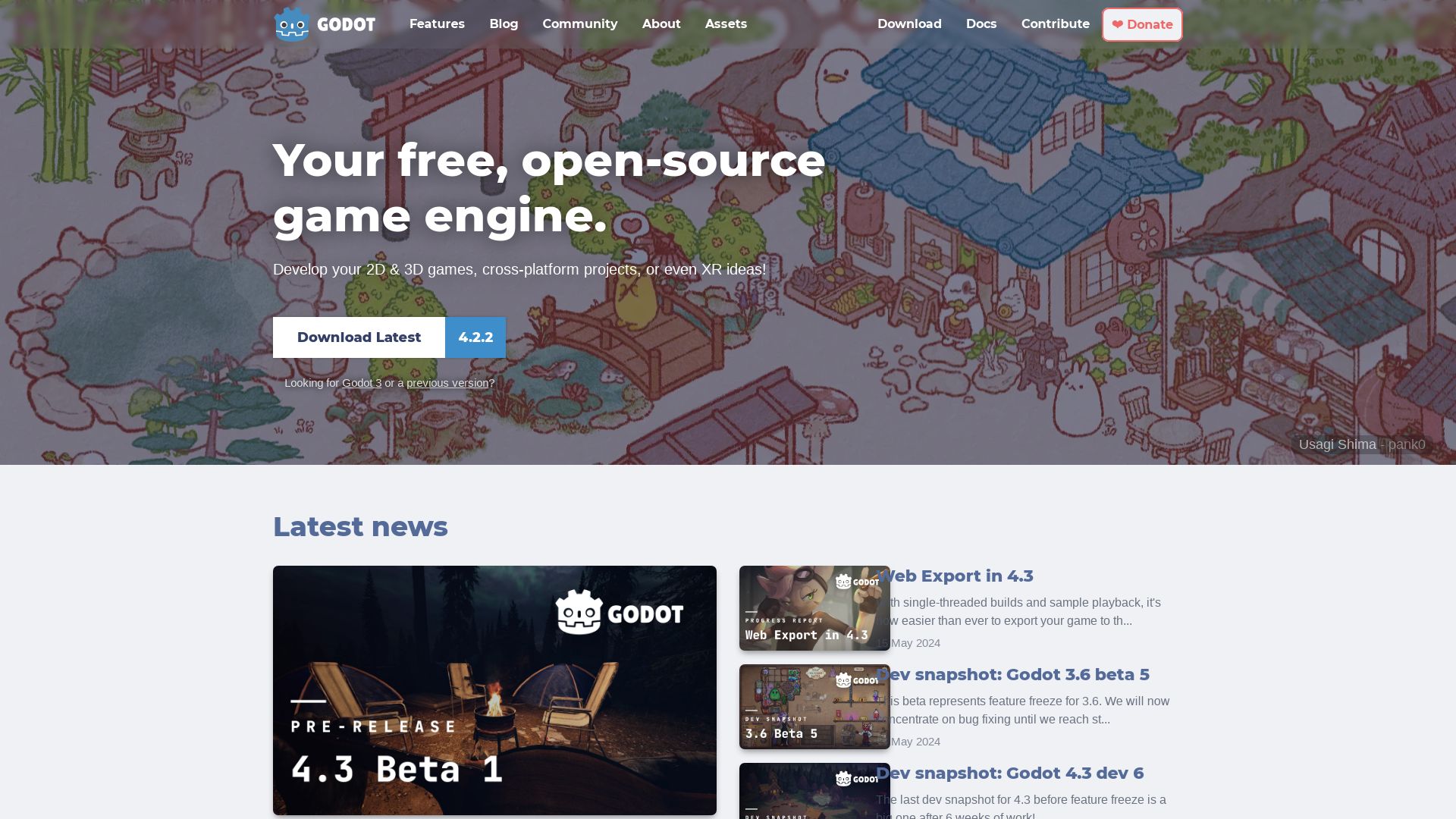
In the realm of game development engines, Godot is a foremost choice. It’s an open-source game engine, making it an ideal choice for user-owned games with no hidden costs.
Godot Top Features
- Intuitive Scene-Driven Design: Building your game from simple blocks is smoothly incorporated through nodes, allowing complex and reusable scenes.
- Tight Engine Integration: This promotes streamlined game logic with the built-in scripting language, GDScript, which supports optional static typing.
- Multi-Language Support: Gods supports C++ and C# for the .NET platform, along with other language bindings like Rust, Nim, and Python through the community.
- 3D & 2D Support: The engine is versatile to support high and low-end devices, allowing direct import of Blender files also offering a specialized workflow for 2D games and apps.
| Platform Support: | Godot is adaptable on multiple platforms including Windows, macOS, Linux, Android, and Web platforms. |
| Sound Editing: | Comprises an Audio Bus/Layout system with real-time effects for superior sound modification. |
| Open Source: | Being free under the MIT license, the hinge of Godot is its open source and modifiable codebase. |
Godot Downsides
- While the 3D engine caters to various devices, it is not suitable for complex 3D game development.
- Though the .NET is supported, it’s only available for desktop platforms in Godot 4.
- Advanced functionality like the official C++ will only be available in the 4.0 with GDExtension API.
Godot Pricing
As a testament to being a developer’s delight, Godot comes with no licensing fees, no contracts, and zero hidden costs. It is free and under the MIT license.
Godot Use Cases
Use case 1
For novices and experienced game developers who seek flexibility and customization, Godot provides an ideal platform.
Use case 2
Freelancers and small development teams will benefit significantly from Godot’s functions, particularly the storage solution designed for team collaboration.
Use case 3
For developers who aim to create games with a strong emphasis on audio, the Audio Bus/Layout system offers a significant advantage.
Unreal Engine
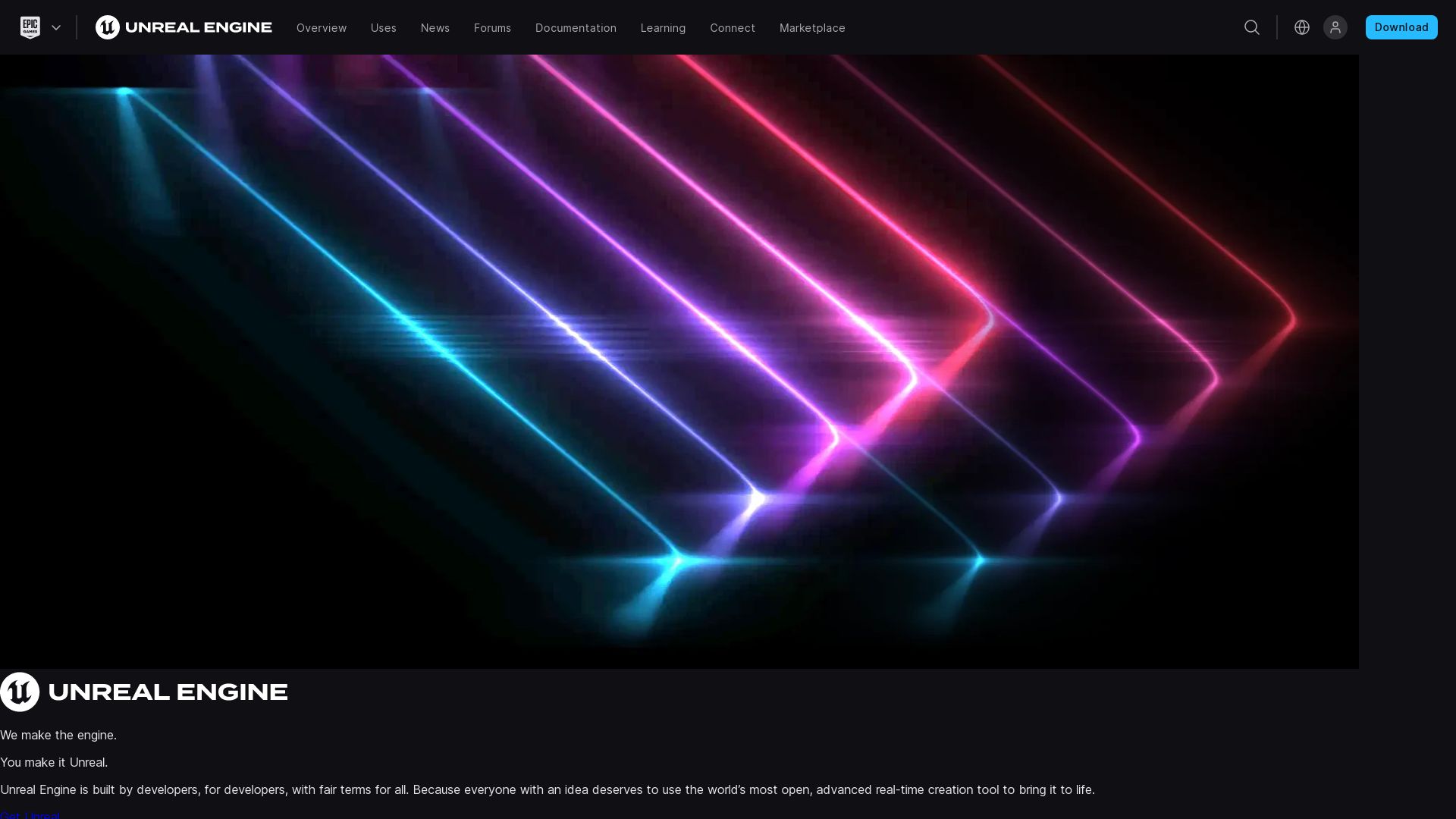
Polished by the masters at Epic Games, the Unreal Engine (UE) is a marvel in the realm of 3D computer graphics and game engines. It came into the limelight with the game ‘Unreal’ in 1998 and now, it has broadened its horizons to an array of game genres and industries!
Unreal Engine’s Top Features
- Written in the foundational in the language of C++, providing developers with supreme flexibility.
- Supports an array of platforms, from desktop and mobile, to console and virtual reality.
- Proudly showcases a level editor, UnrealEd, for real-time constructive solid geometry operations.
- Incorporated with features from acquired companies such as Quixel.
| Additional Feature | Description |
|---|---|
| Unreal Development Kit (UDK) | Launched in 2009, it’s a free version of UE3’s Software Development Kit (SDK), supporting the creation of iOS games and apps. |
| Unreal Engine Marketplace | A bustling hub for developers to sell their creations or purchase the work of other skilled individuals. Epic respects the sweat and blood of content creators with an 88% share of revenue. |
Unreal Engine Limitations
- Learning curve can be steep as C++ has a reputation for being complex and difficult for beginners.
- Commercial use is subject to royalty payments above a certain threshold of revenue.
Unreal Engine Pricing
Unreal Engine is freely accessible. However, a 5% of revenues over USD 1 million is charged for commercial use. The royalty model is waived off for games published on the Epic Games Store.
Unreal Engine Use Cases
Use case 1 – Game Development
Indie developers and big game studios alike can leverage the engine to create visually stunning and interactive games for different platforms.
Use case 2 – Film and Television
Film and TV production companies can harness Unreal Engine’s robust capabilities for real-time 3D rendering, creating immersive visuals and digital environments.
Use case 3 – Education
With its free access for schools and universities, Unreal Engine serves as an excellent resource for students learning game development or computer graphics.
GameMaker
Unveiling the world of 2D gaming, GameMaker is a game engine appreciated for its simplicity and scalability, enabling both novice programmers and full-time developers to invent stunning games like Undertale, Forager, and Chicory: A Colorful Tale.
GameMaker Best Features
- Easy-to-learn, yet comprehensive toolkit for creating diverse 2D games
- Integrates a Language Server for Syntax Highlighting and Intellisense support – accommodates variety of languages within the Code Editor such as Shader Languages (GLSL, HLSL, etc), JSON, and XML
- It nurtures user-generated content via Mod.io extension
- A robust feedback system allowing engine updates to strike a balance between new features, maintenance and customer feedback.
| Specialty | Details |
|---|---|
| New Code Editor Envisaged | The anticipated code editor, to be launched in 2023, will allow more accessible objects, events, and functions management within a fullscreen window |
| AI Integration | In partnership with OpenAI, GameMaker is paving the path towards AI support to further streamline the game-making process |
GameMaker Downsides
- Limited primarily to 2D games, thus may not be the preferred option for 3D game developers
- New features and updates may take a while due to the need to balance maintenance and customer feedback
GameMaker Pricing
GameMaker offers various pricing tiers: a free version for beginners, a Creator Version aimed at game development on desktop stores, Indie Version for game release with varied export options, and an Enterprise Version for major console studio releases.
GameMaker Use Cases
Use case 1
For hobbyist game developers or those looking to get their feet wet in the realm of game development, GameMaker serves as an ideal starting point with its simple interface and free tier offering.
Use case 2
For Indie game developers seeking to release their games with multiple export options, the Indie Version of GameMaker becomes an optimal choice.
Use case 3
The Enterprise Version caters well to established studios planning major console releases due to its robust feature set.
Android Studio
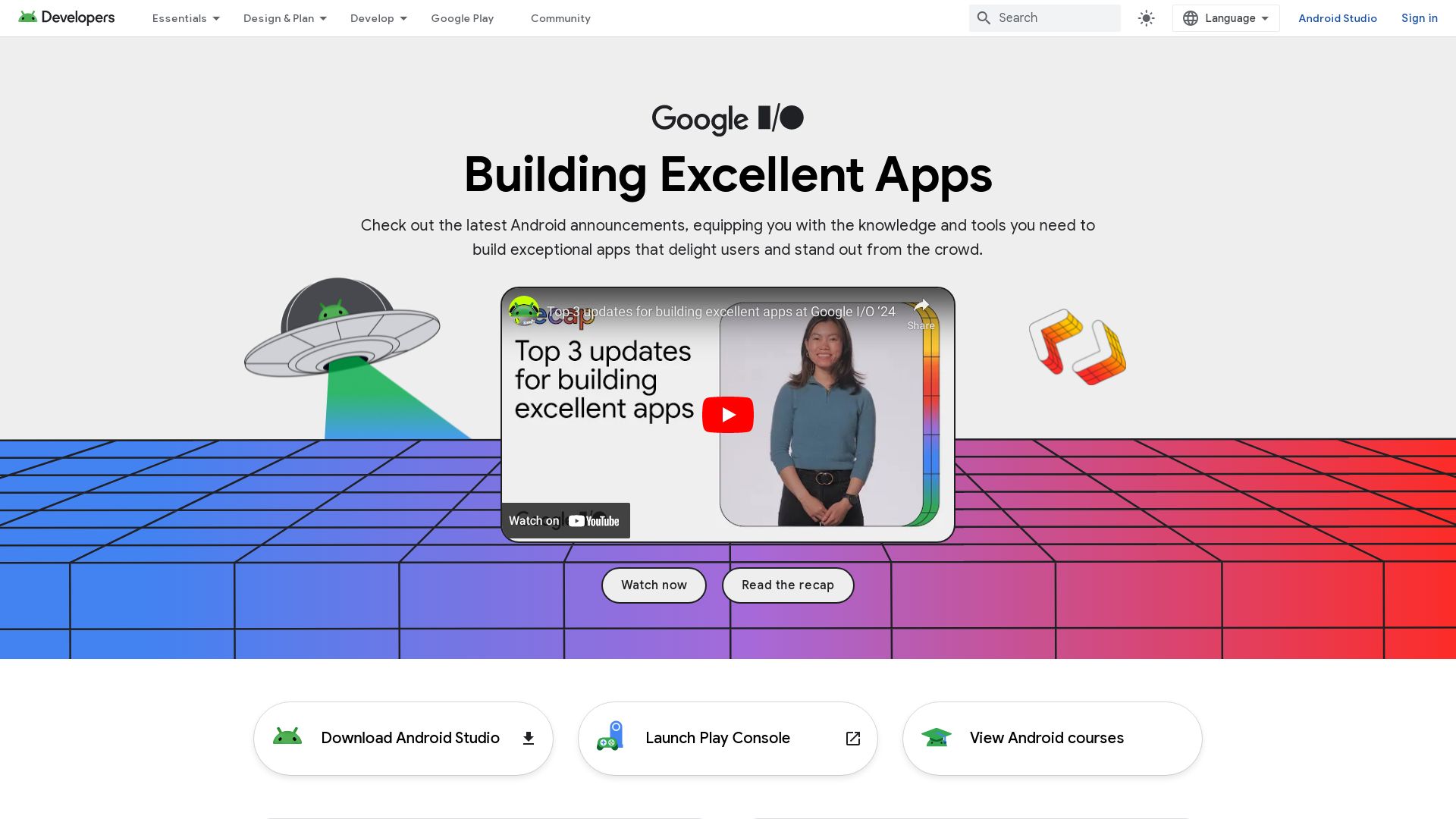
The official IDE for Android app development, Android Studio encapsulates flexibility, efficiency, and comprehensiveness into one powerful developer tool.
Android Studio Top Features
- Builds on IntelliJ IDEA code editor and offers an agile Gradle-based build system.
- Provides development capabilities across all Android devices.
- Allows live editing for real-time mobile composite updates.
- Support for both C++ and NDK, with integrated Google Cloud Platform.
- Offers multiple APK creation from the same project and modules.
- Enables resource and code reuse across source sets.
- Comprehensive testing tools and lint tools for performance, usability, and version compatibility.
| Android Studio Feature | Advantage |
|---|---|
| Code Templates | Facilitates feature building and sample code import. |
| GitHub Integration | Streamlines code sharing and collaboration. |
| Smart Editing and Code Refactoring | Delivers high-quality app development with deep static code analysis. |
Android Studio Limitations
- Requires a minimum of 8 GB RAM and 8 GB disk space for optimal performance.
- Its powerful features may seem complex to beginners.
- The large size of the IDE could lead to slower performance on low-end systems.
Android Studio Use Cases
Use case 1
Android App Development: Android Studio is perfectly equipped for developing high-performance apps compatible with Google Play Store’s developer content policy.
Use case 2
App Testing: With extensive testing tools, including a fast emulator, Android Studio allows developers to streamline the app testing process.
Use case 3
Integrated App Development: In addition to Android development, Android Studio offers built-in support for Google Cloud Platform, enabling developers to build integrated apps with cloud capabilities.
Solar2D

In the grand amphitheater of game development engines, one name reverberates across the marbled columns and arches with commanding presence – Solar2D. A successor to the illustrious Corona SDK with over a decade of ceaseless evolution, Solar2D has gracefully adorned the mantle of a versatile platform for cross-platform mobile app development. It traces its illustrious lineage back to December 2009, educating and empowering developers with an exceptional suite of design tools and a ubiquitous platform that supports an extensive range of devices including iOS, tvOS, Android, Android TV, macOS, Windows, Linux, and HTML5.
Solar2D Top Features
- Single code base offering significant cost and time efficiencies; enables development for multiple platforms with consummate ease.
- An impressive library of plugins to cater to in-app advertising, analytics, media amongst other requirements. These extensions offer greater versatility and can be accessed freely through Solar2D Marketplace and Solar2D plugins.
- Integrated Lua layered seamlessly over C++/OpenGL with two operational modes at disposal: Solar2D Simulator for direct app building and Solar2D Native for integration of Lua code and assets within an Xcode or Android Studio project.
| Feature | Details |
| Solar2D Native | Allows developers to call native libraries/APIs like C, C++, Objective-C, and Java, offering you unprecedented control over your mobile application(s). |
| Instant-update Simulator | Enables real-time testing for instantaneous changes to code or assets, accelerating the development process considerably. |
Solar2D Downsides
The details related to some limitations or downsides of Solar2D have not been explicitly outlined in this company summary.
Solar2D Pricing
Driven by a commitment to the development community, Solar2D is 100% free. It imposes no hidden costs and collects no royalties, making it an attractive proposition for developers of all scale and scope. Further enriching its reputation is its privacy policy – there is no tracking or data gathering to concern yourself with.
Solar2D Use Cases
Use case 1: Rapid Mobile App Development
Solar2D’s integrated Lua-based development environment aids the swift construction of mobile applications. From game developers crafting the next runaway hit to application enthusiasts nursing an original idea – the potent synergy of Solar2D’s instant-update simulator and numerous designing options results in an uncanny acceleration of the development process.
Use case 2: Integrated Ad Support for Quicker Monetization
Every development project aims at a sweet climax – the point where the app begins to generate revenue. Solar2D increases the pace at which this goal is achieved, thanks to its integrated ad support. Advertisements are a popular revenue stream for many applications. Acknowledging this, the Solar2D platform ensures that you can monetize your application effectively, efficiently, and most importantly, quickly.
Use case 3: Open Source Desktop Application Development
Solar2D is not just confined to mobile applications. The software extends its eminence to desktop applications too, supporting Windows, Linux, and macOS. As the technology is open-source under an MIT license, developers retain their rights to the source code, opening up a realm of possibilities for modification and distribution.
RPG Maker
An exalted name in the realm of game development engines, RPG Maker stands as a powerful tool primarily for the creation of story-driven RPGs. Developed by an array of companies including ASCII and Enterbrain, RPG Maker solidified its legacy since its inception in 1992.
RPG Maker Top Features
- Easy-to-use interface, designed openly for users without coding knowledge.
- Robust character creation options, permitting full customization of the gaming universe.
- Astonishing array of DLCs, extending dynamics of game development.
- Wide language support including Japanese, English, Chinese, and Korean.
- Implemented free plugins, enriching the scope and potential of game design.
| Feature | Benefit |
|---|---|
| JavaScript and HTML5 based | Offers more flexibility with advanced customizations. |
| Community support | Allows sharing of modifications, aiding in overcoming software limitations. |
| Cross-platform support | Includes Windows, Mac, PlayStation versions and many more. |
RPG Maker Limitations
- The engine’s limitations can restrict certain design elements, demanding a skilled developer for optimal utility.
- The propensity for controversy, as evidenced by releases like “Super Columbine Massacre RPG!” and “Heartbeat”.
RPG Maker Pricing
Different variations of RPG Maker, like the latest RPG Maker MV, offer over 200 DLCs priced between <$5-$25>, ensuring a suitable subscription for varied users.
RPG Maker Use Cases
Use case 1 – Beginners
The simplicity of RPG Maker makes it desirable for novice developers seeking to acquire proficiency in game development.
Use case 2 – Story-driven development
For those passionate about weaving intriguing narratives within their games, RPG Maker’s emphasis on story-driven elements offers an ideal platform.
Use case 3 – RPG enthusiasts
For ardent fans of RPG titles akin to early Final Fantasy games, RPG Maker’s 2D sprite-based perspective provides an authentic recreation of classic RPG games.
Panda3D

Roaring into the game development arena is Panda3D, a brute-force engine packing a punch for 3D rendering and game development in Python and C++. This isn’t your run-of-the-mill piece of kit. Birthed from the kingpins of imagination – Disney Interactive, Panda3D is no amateur’s playground. Python and C++ are the dual swords it wields.
Top Panda3D Features
- Open-source engine with full Python and C++ support
- Modern per-pixel lighting techniques with driver-friendly shaders and detailed graphics
- 3D audio support using FMOD, OpenAL or Miles Sound System
- Robust physics system for immersive gameplay and detailed collision detection
- Interactivity with keyboards and mice, easy networking, and complex AI functionality
| Third-Party Libraries Compatibility | Building and Configuration | Community Support |
|---|---|---|
| Incorporates third-party libraries such as FMOD, Nvidia Cg, DirectX, MFC. | Distinct building instructions for different OSes: Windows, Linux, FreeBSD, MacOS. | Open to bug reports via GitHub and maintains a strong community of experienced developers. |
Panda3D Limitations
- Not suitable for beginners as it requires basic knowledge of Python and APIs
- The Android cross-compile option is available but can have occasional hitches
Panda3D Pricing
Hold the press, Panda3D is completely free for public use. That’s right, this dynamic, power-packed engine won’t cost you a dime. It’s open-source, robust, and perfect for developers who fancy a cost-effective yet powerful tool.
Panda3D Use Cases
Use Case 1: Commercial Game Developers
With detailed graphics, robust collision detection, and advanced AI, Panda3D is a favorite for commercial game developers looking to create immersive gameplay experiences.
Use Case 2: University Courses and Research Projects
Due to its roots in VR research, Panda3D continues to be a valuable tool for university courses and research projects centered on VR and gaming.
Use Case 3: Open-Source Game Projects
Being an open-source engine, Panda3D is the go-to choice for developers undertaking open-source game projects.
Stride
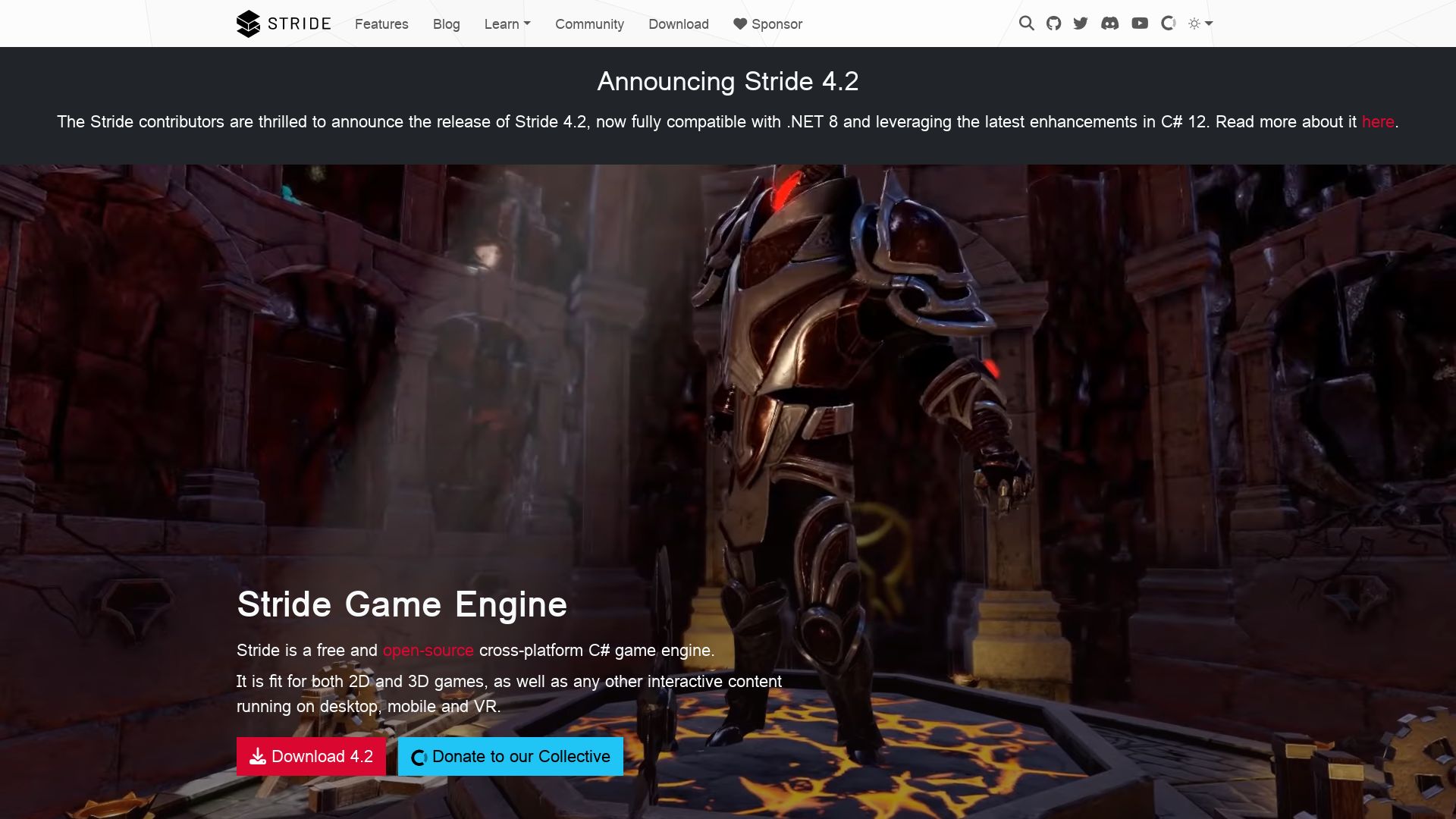
An impressive open-source alternative to GameSalad, Stride is power-packed with features for cross-platform 2D and 3D game creation.
Stride Top Features
- C# suite tools: for advanced programming
- Customizable shader system: for enhanced graphical rendering
- Game Studio: An integrated evironment for complete game development workflow.
- Photorealistic postprocess effects and Physically-Based Rendering (PBR) layered material editor for high-quality visuals
- Scripting editor, sprite editor, UI engine: for comprehensive game building experience
| Initial Release | September 2014 |
| Cross-platform Compatibility | iOS, Android, Windows UWP, Linux, PlayStation 4 |
| Additional Uses | 3D rendering engine for vvvv gamma |
Stride Limitations
- The learning curve can be steep for beginners, as it requires familiarity with C#.
- It has a community-supported model and received its last developer support in August 2018.
Stride Pricing
Stride is a free open-source game engine, enabling cost-effective game development.
Stride Use Cases
Use case 1
For indie game developers, Stride offers a comprehensive toolkit and cross-platform compatibility to release games on multiple platforms.
Use case 2
Education Institutions can leverage Stride to teach advanced game development, offering hands-on experience with an industry-grade engine.
Use case 3
Stride serves as a 3D rendering engine for the visual programming environment vvvv gamma, expanding its use beyond game development.
Tiffany Brise
Content writer @ Aircada, patiently awaiting a consumer AR headset that doesn’t suck.



